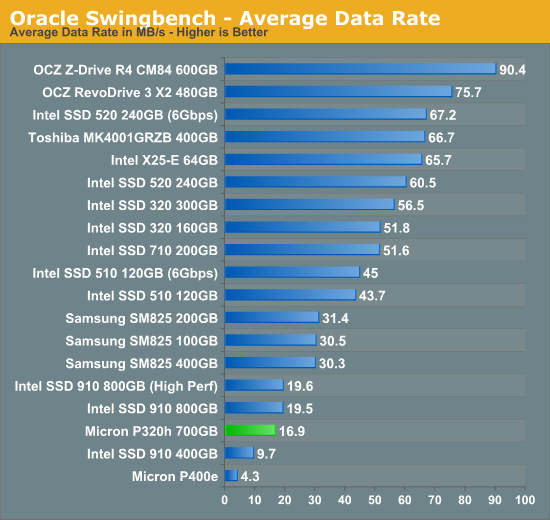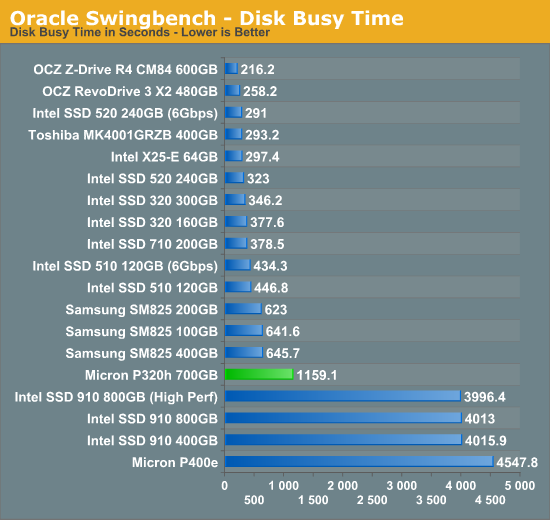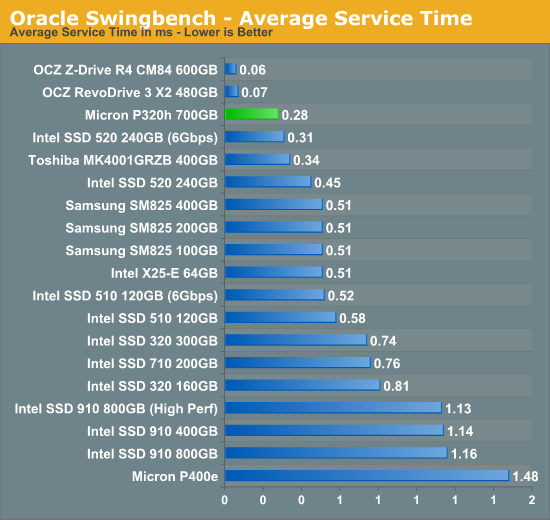Micron P320h PCIe SSD (700GB) Review
by Anand Lal Shimpi on October 15, 2012 3:00 AM ESTEnterprise Storage Bench - Oracle Swingbench
We begin with a popular benchmark from our server reviews: the Oracle Swingbench. This is a pretty typical OLTP workload that focuses on servers with a light to medium workload of 100 - 150 concurrent users. The database size is fairly small at 10GB, however the workload is absolutely brutal.
Swingbench consists of over 1.28 million read IOs and 3.55 million writes. The read/write GB ratio is nearly 1:1 (bigger reads than writes). Parallelism in this workload comes through aggregating IOs as 88% of the operations in this benchmark are 8KB or smaller. This test is actually something we use in our CPU reviews so its queue depth averages only 1.33. We will be following up with a version that features a much higher queue depth in the future.

Intel's SSD 910 didn't do well at all in our Oracle Swingbench test, mostly due to its inability to perform well at very small transfer sizes (512B). The P320h is no different here and is easily outperformed by standard 2.5" SATA SSDs (although Micron's P400e also does really poorly here). The results here just go to show how important it is that you understand your workload when picking an enterprise SSD.
Average service time is nice and low for the P320h, it's just we don't end up seeing a high throughput rate for the SSD.












57 Comments
View All Comments
PCTC2 - Monday, October 15, 2012 - link
I think some of you guys are missing the point. This is an enterprise drive. You are not going to be booting off of it. You are not going to find it cheap or in smaller sizes. This drive, if it was a car, would be the unholy child of a European supercar and a Marauder. I could put one of these in a compute cluster and slam it 24/7 and it would be happy. And I would be happy because it means that I don't have to worry about hitting NAND endurance limits and I have a low-latency, highly parallelized storage device.So no. I (and probably anyone else who deals with enterprise hardware) don't care that it isn't bootable. I don't want it bootable. I don't care that it probably costs $5000+ for 700GB. It's cheaper in the long run. If it was to be anywhere close $300, you would have probably have 128GB of raw eMLC NAND, before over provisioning/RAIN/etc. Who in the industry would want such a small PCIe SSD when its strength is the large number of channels and large capacity.
But would I give my right testicle to be able to eval one of these units, possibly buying enough for all of the servers? Yes. I probably would.
DukeN - Tuesday, October 16, 2012 - link
So you'd buy this for all your servers without figuring out how to add disk redundancy for these things?Or if you could RAID them, how that would affect the lifetime and TRIM-related performance.
DataC - Tuesday, October 16, 2012 - link
Dear PCTC2, I’m with Micron and our engineering team loves your Marauder/Supercar analogy. If you’re serious about that eval unit, we should chat. You can reach me at SSD@micron.com.And I promise our eval terms don’t require quite as much commitment as you’ve suggested....
DukeN - Monday, October 15, 2012 - link
Sorry, but no enterprise is putting their Oracle or MSSQL clusters on a platform based just on individual disk benchmarks.Numbers compared to disk arrays, SAN devices, etc would be welcome. Also, no enterprise will run something like this without redundancy which brings up another slew of questions - TRIM, wear-levelling, etc.
Thanks
SQLServerIO - Monday, October 15, 2012 - link
There are only two cards that I'm aware of that are similar. Fusion-io with their line of cards and Texas Memory Systems which was acquired by IBM recently.The big difference between this card and the Fusion-io card is where it stores its LBA's and block mappings. The TMS drive and this drive both store that on the drive either in DRAM or flash on PCB. The fusion-io cards use your system memory.
On the latency side, fusion-io has very solid latency numbers even on their MLC products. This card between the native PCI-e interface and using SLC make it very competitive.
I am worried about the driver issues, this is a HUGE problem for those of us running on windows. TMS and fusion-io both have had driver problems but with products that have been on the market for several years now have ironed them out. Micron being very late to the game can't afford to have these issues at launch even though they are disclosing them it will cut them off from a lot of the smaller shops that would buy from them.
I would like to know how many channels are active out of the 32 available at a time. If they come back and say all 32 that is also concerning pointing to bottlenecks in their custom ASIC with this much SLC flash on board.
Just my thoughts.
Wes - www.sqlserverio.com
FunBunny2 - Monday, October 15, 2012 - link
And no encryption? In an Enterprise drive? Also, the R/W performance difference is puzzling.jospoortvliet - Tuesday, October 16, 2012 - link
You should run a load which requires hardware like this on an enterprise OS, not a playtoy as Windows... I think the comment about 32 vs 512 QD made that clear already. MS is nice for SMB with unskilled workers due to familiarity. But prise-performance it's crappy (requires lots of maintenance) andYour choices would be:
https://www.suse.com/products/server/
http://www.redhat.com/products/enterprise-linux/
That's what you use at, for example, at the London Stock Exchange. Just google "london stock exchange linux dotnet" and see how MS failed at a real demanding workload and the Stock Exchange lost billions on a bad bet.
But I guess you'll have to ignore all that as you're not trained for anything else :D
jospoortvliet - Tuesday, October 16, 2012 - link
(missing part would of course be "... and it fails completely at more demanding workloads")DataC - Tuesday, October 16, 2012 - link
I’d like to respond to the drivers concern. I work for Micron in our SSD organization and can certify that we have fully tested our drive in two server-class Windows-based operating systems (in addition to Linux). These are Windows Server 2008 and 2012. This is an Enterprise-class drive and as such we currently do not support desktop operating systems such as Windows 7. Some of the chipset compatibility issues like the H67 fall also into the category of desktop systems and as such we do not explicitly support them. Understandably, while this makes reviewing the card somewhat difficult (most reviewers don’t want to spend $10K+ on a server) we need to be clear that this is not a driver maturity issue but a conscious decision we made to support datacenter, server-grade hardware and OSs.boogerlad - Monday, October 15, 2012 - link
Ah, just the review I was waiting for. This drive isn't usable as an os boot drive? How unfortunate...